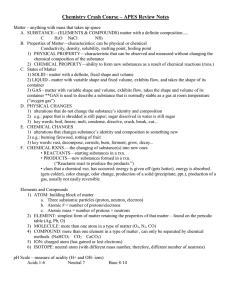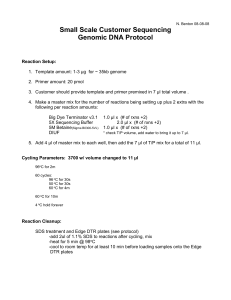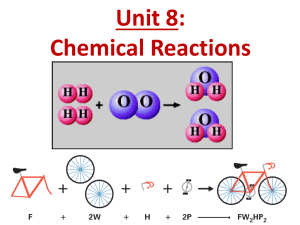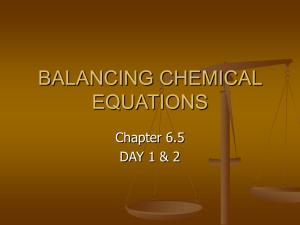Chemical Reactions
advertisement
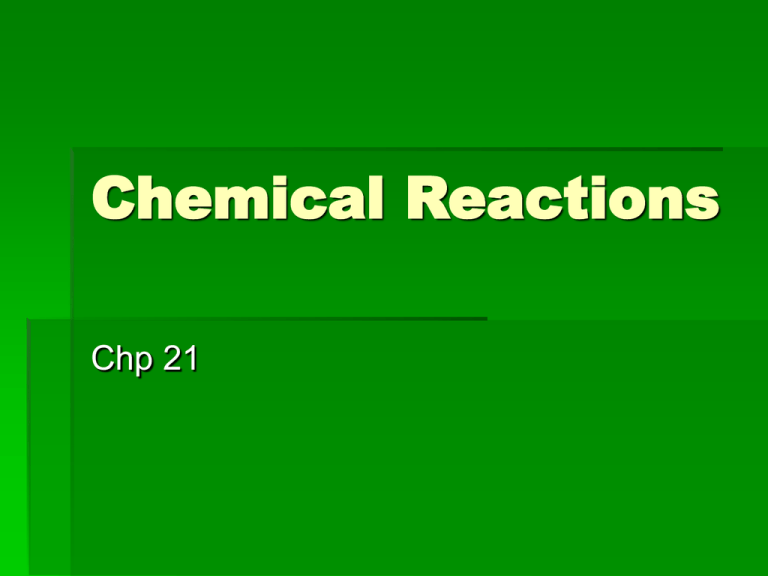
Chemical Reactions Chp 21 Chemical Reactions Section1 Chemical Reactions slides 3-20 Section 2 Chemical Equations slides 21-34 Section 3 Classifying Chemical Reactions slides 35-46 Sections 4 Chemical Reactions & Energy slides 47-61 Section 1 Chemical Changes What You’ll Learn: How to identify the reactants & products in a chemical reaction How a chemical reaction follows the law of conservation of mass How chemists describe chemical changes with equations Describing Chemical RXNs Chemical reactions happen all around you & even inside your body! A chemical reaction is a change in which one or more substances are converted into new substances. Describing Chemical RXNs Chemical reactions happen all around you & even inside your body! A chemical reaction is a change in which one or more substances are converted into new substances. A reactant is one of the substances that react. A product is one of the new substances that are produced. Describing Chemical RXNs Reactants products produce A reactant is one of the substances that react. A product is one of the new substances that are produced. Conservation of Mass Antoine Lavoisier discovered that the total mass of the products of a RXN always equals the mass of the reactants. He showed the mass of a candle and the air in a jar is the same as the mass of the products after burning. What were Lavoisier’s experiments? He wanted to know exactly what happened when substances changed form so he experimented with mercury. What were Lavoisier’s experiments? He wanted to know exactly what happened when substances changed form so he experimented with mercury. He put solid mercury (II) oxide, a red powder, in a sealed container, found its mass and then heated the container so that the powder changed to a silvery liquid, metal mercury, after giving off a gas. What were Lavoisier’s experiments? Then he took the mass of the products in the container which remained the same as before. Mercury (II) oxide oxygen + mercury 10 g = 0.3 g + 9.7 g What were Lavoisier’s experiments? He also realized the gas produced, oxygen, was a part of air. Air combined with the mercury metal when heated to make mercury (II) oxide. He studied the effect of oxygen on living animals and humans. In hundreds of experiments in his lab he confirmed the law of conservation of mass. Why is Lavoisier called the father of modern chemistry? His explanation of the law of conservation of mass started modern science. He was the first to describe a chemical RXN called combustion. Why are names important? In 1787, Lavoisier & other scientists wrote the first instructions for naming compounds because they needed a better way to describe their ideas so they could clearly understand each other. Why are names important? In 1787, Lavoisier & other scientists wrote the first instructions for naming compounds because they needed a better way to describe their ideas so they could clearly understand each other. The guidelines continue to evolve. In 1919, the Intn’l Union of Pure & Applied Chemistry (IUPAC) was formed to coordinate guidelines. Writing Equations It’s important to include all the info when you describe a RXN. The shortcut method to describe the RXN is called a chemical equation & uses chemical formulas & other symbols. Symbols used in Chemical Equations Symbol Meaning Symbol Meaning Produces or forms (aq) Aqueous, dissolved in water + plus Heat Reactants are heated (s) solid Light Reactants are exposed to light (l) liquid Elec. Current applied to reactants (g) gas Writing Equations Nickel (II) chloride, dissolved in water, pus sodium hydroxide, dissolved in water, produces solid nickel (II) hydroxide plus sodium chloride, dissolved in water. OR NiCl2 (aq) + 2NaOH (aq) Ni(OH)2 (s) + 2NaCl (aq) Both statements mean the same thing! Unit Managers NiCl2(aq) + 2NaOH(aq) Ni(OH)2(s)+2NaCl(aq) A coefficient shows the number of units of a substance taking part in a reaction. Atoms are rearranged but they are never destroyed. Count the atoms on both sides of the equation above. Are they equal? How do chemists use coefficients? When chemists know the number of units of each reactant, they are able to add the correct amounts of reactants for a reaction. The units or coefficients tell how much product will form. How do chemists use coefficients? NiCl2(aq) + 2NaOH(aq) Ni(OH)2(s)+2NaCl(aq) Cl Ni+2 Cl + Na OH Na Cl OH Na OH Ni+2 OH + Na Cl Section 2 Chemical Equations What You’ll Learn: What a balanced equation is How to write a balanced chemical equation 2 Balanced Equations Lavoisier’s mercury (II) oxide RXN: heat HgO(s) Hg(l) + O2(g) Count the numbers of atoms on each side. What do you notice? 2 Balanced Equations Lavoisier’s mercury (II) oxide RXN: heat HgO(s) Hg(l) + O2(g) Count the numbers of atoms on each side. What do you notice? How can we make the oxygen balance without changing the compound produced? Balanced Equations Atoms HgO Hg 1 O 1 Hg + O2 1 2 What does a balanced equation show? To balance a chemical equation, you change the coefficients. A balanced chemical equation has the same number of atoms of each element on each side of the equation. How do you choose coefficients? Guess & check Balanced Equations Atoms 2HgO Hg 2 O 2 Hg + O2 1 2 This balances the oxygen but not the mercury. Let’s try a 2 in front of the mercury on the right side… Balanced Equations Atoms 2HgO Hg 2 O 2 2Hg + O2 2 2 Now the equation is balanced with equal numbers of each atom on reactant and product sides. What are the steps for balancing an equation? Write a balanced chemical equation for the burning of magnesium: Step 1 Write a chemical equation with symbols and formulas. Ex. Mg(s) + O2(g) MgO(s) Remember oxygen is a diatomic molecule with 2 oxygen atoms in a covalent bond. What are the steps for balancing an equation? Step 2 Count the atoms in the reactants & products. The magnesium atoms are balanced, but the oxygen atoms are not. Atoms Mg Mg 1 O + O2 MgO 1 2 1 What are the steps for balancing an equation? Step 3 Choose coefficients to balance the equation. You cannot change subscripts of a formula to balance an equation. Atoms Mg Mg 1 O + O2 2MgO 2 2 2 What are the steps for balancing an equation? Step 4 Check the number of atoms on each side. You need to add the coefficient 2 in front of the magnesium to balance the equation. Atoms 2Mg Mg 2 O + O2 2MgO 2 2 2 Now Try Balancing This: ___Fe + ___Cl2 ___FeCl3 b c a Now Try Balancing This: ___Fe + ___Cl2 ___FeCl3 b c a 2Fe + 3 Cl2 2Fe Cl3 Section 3 Classifying Chemical Equations What You’ll Learn: What the five kinds of chemical reactions are What oxidation & reduction are What a redox reaction is Which metals replace others in compounds 3 Types of Reactions Scientists organize or classify reactions into five types: Combustion Synthesis Decomposition Single displacement Double displacement What are combustion reactions? A combustion reaction occurs when a substance reacts with oxygen to produce heat and light. Ex. Burning something. Combustion produces one or more products that contain elements of the reactants. Sometimes combustion RXNs are also other types of reactions at the same time. What are synthesis RXNs? In a synthesis reaction, 2 or more substances combine to form another substance. The general formula is A +B AB or A reacts with B to form AB. An example is hydrogen burning in oxygen to form water: 2H2(g) + O2(g) 2H2O(g) What are synthesis RXNs? An example is hydrogen burning in oxygen to form water: 2H2(g) + O2(g) 2H2O(g) This RXN is used to power some rockets, including the main engines of a space shuttle. Rust is another product of a synthesis RXN between iron and oxygen. What are decomposition RXNs? The reverse of a synthesis RXN, decomposition reaction occurs when one substance breaks down into 2 or more substances with the general formula of AB A + B. Most decomposition RXNs use heat, light or electricity. What are decomposition RXNs? An electric current passed through water produces hydrogen and oxygen. This reaction is also referred to as electrolysis. What are singledisplacement RXNs? A single-displacement reaction happens when one element replaces another element in a compound. The general formula for it is A+BC AC+B. Atom A displaces atom B forming a new molecule AC. Ex. When copper wire is put in a solution of silver nitrate: Cu(s)+2AgNO3(aq) Cu(NO3)2(aq)+ 2Ag(s) What is the activity series? You can predict which metal will replace another metal in displacement RXNs. The diagram lists metals by how reactive they are with the most active at the top & least active at the bottom. Note: Cu, Ag & Au found in relatively pure deposits. What are doubledisplacement RXNs? The positive ion of one compound replaces the positive ion of the other compound to form two new compounds. The general formula is: AB +CD AD +CB. An example…. Ba(NO3)2(aq) + K2SO4(aq) BaSO4(s) + 2KNO3(aq) What are oxidationreduction reactions? In many RXNs, substances gain or lose electrons. Oxidation is a loss of electrons during a chemical reaction. Reduction is a gain of electrons during a chemical RXN. Electron transfer often involves oxygen; because it’s very reactive, it often pulls electrons from metals causing them to corrode or rust. What are oxidationreduction reactions? The substance that gains electrons becomes negative so it is reduced. The substance that loses electrons becomes more positive or oxidized. Redox- reductionoxidation Section 4 Chemical Reactions & Energy What You’ll Learn: Energy changes sources in chemical reactions The difference between exergonic & endergonic reactions How catalysts & inhibitors are used 4 Chemical RXNs & Energy Dynamite can be used to demolish old buildings. A dynamite explosion is an example of a rapid chemical RXN. 4 Chemical RXNs & Energy Dynamite can be used to demolish old buildings. A dynamite explosion is an example of a rapid chemical RXN. All chemical RXNs either release or absorb energy in the form of heat, light, sound or electricity. 4 Chemical RXNs & Energy Dynamite can be used to demolish old buildings. A dynamite explosion is an example of a rapid chemical RXN. All chemical RXNs either release or absorb energy in the form of heat, light, sound or electricity. Chemical bonds are the source of this energy. More Energy Out An exergonic reaction releases energy. Less energy is needed to break the bonds in the reactants than is released when the new bonds in the products form. Exergonic reactions give off energy such as heat or light like that from a glow stick. What are exothermic reactions? A reaction with energy given off as heat is an exothermic RXN. Heat packs, burning wood, rusting iron and exploding dynamite are examples. What are exothermic reactions? The energy you are using today probably came from exothermic RXNs at a power plant that burns fossil fuels. Other products of that RXN include pollutants such as sulfur dioxide. More Energy In An endergonic reaction absorbs energy since it takes more energy to break the bonds in the reactants than is released when new bonds in the products form. More Energy In An endergonic reaction absorbs energy since it takes more energy to break the bonds in the reactants than is released when new bonds in the products form. Endergonic RXNs absorb energy such as heat, light or electricity. More Energy In An endergonic reaction absorbs energy since it takes more energy to break the bonds in the reactants than is released when new bonds in the products form. Endergonic RXNs absorb energy such as heat, light or electricity. Electroplating puts a coat of metal onto a surface. Electricity is also used to separate aluminum metal from ore. More Energy In In the following endergonic reaction, energy from electricity keeps the reaction going. electricity 2 Al2O3(l) 4Al(l) + 3O2(g) What is an endothermic RXN? An endothermic reaction absorbs energy, usually as heat. When an endothermic RXN takes place in a beaker, it can make the beaker feel cold. Physical changes also can be described as endothermic such as salt dissolving in water or ice like that in an ice cream freezer. What is an endothermic RXN? When barium hydroxide reacts with ammonium chloride in a beaker of water, it is so endothermic that it causes a drop of water on the outside of the beaker to freeze. Cold packs contain ammonium nitrate crystals and water. What are catalysts? A catalyst is a substance that speeds up a chemical RXN without being permanently changed itself. The catalyst can be recovered and reused. What are inhibitors? Sometimes, it is helpful to prevent or to slow down chemical reactions with an inhibitor. Like catalysts, inhibitors do not change the amount of product produced in a RXN. Food preservatives called BHT & BHA are inhibitors that prevent food spoilage.
